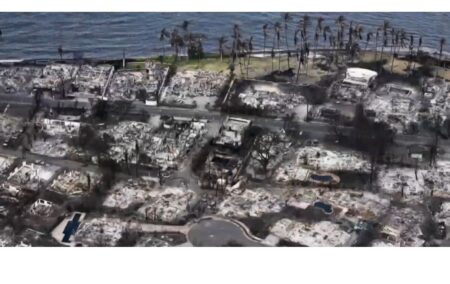Wildfires that have torn through the Hawaiian island of Maui, have killed as many as 80 people, and charred parts of the island.
The fires devastated the historic town of Lahaina, a popular tourist destination that’s home to 12 000.
Daniel Swain, a climate scientist at the University of California in Los Angeles told the Wall Street Journal that a confluence of powerful downslope winds, an existing moderate to severe drought, and invasive grasses helped fuel this disaster.
‘It was the perfect storm,’ he said.
Winds from Hurricane Dora, a Category 4 hurricane spinning nearly 1 300 kilometres southwest of Honolulu, fanned the flames.
The hurricane created high-speed winds reaching 100 kms per hour on Tuesday. Downslope winds from the mountain dried out the air, exacerbating the dangerous conditions.
On Tuesday, small fires on the foothills quickly grew and spread to Lahaina, destroying much of the town. Authorities said they had prepared for the hurricane but not the fires that followed.
The fire spread so rapidly in some places that Maui’s Emergency Management Agency couldn’t sound an emergency alarm before it arrived.
The Wall Street Journal reports that a decline in farming also raises the risks of wildfires. Land once used to grow pineapple or sugar cane is now filling up with waist-high grass that isn’t native to Hawaii. Without rain, the grass dries out rapidly. When it ignites, it becomes explosive.
As farms disappeared, so did the roads and water reservoirs used by farmers, making it tougher for firefighters to get to fires and put them out.
[Image: Screenshot]

